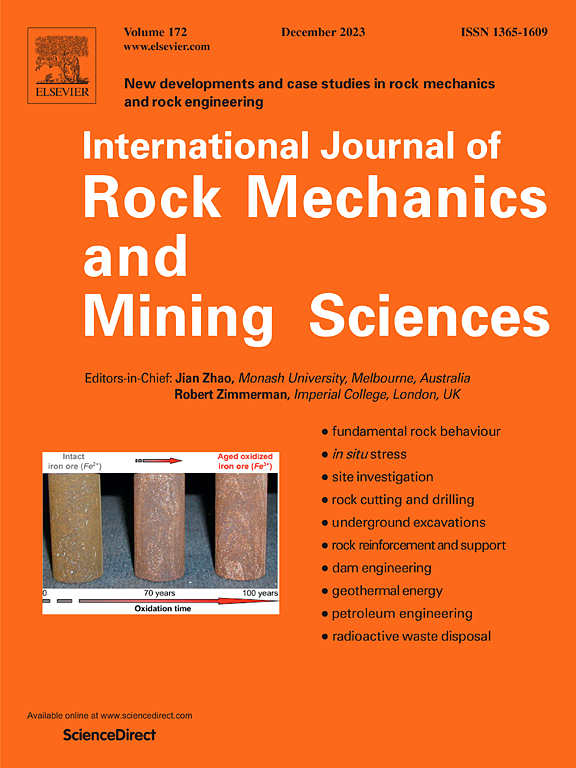Pore-scale damage evolution in sandstone induced by fluid infiltration under various stress conditions
IF 7.5
1区 工程技术
Q1 ENGINEERING, GEOLOGICAL
International Journal of Rock Mechanics and Mining Sciences
Pub Date : 2025-06-19
DOI:10.1016/j.ijrmms.2025.106181
引用次数: 0
Abstract
While stress-dependent fluid infiltration plays a critical role in the initiation and propagation of hydraulic fractures, limited attention has been paid to the dynamics of fluid infiltration and the pore-scale damage mechanisms resulting from fluid infiltration during hydraulic fracturing. To address these research gaps, this study conducts hydraulic fracturing experiments on tight sandstone under various stress levels, employing nuclear magnetic resonance (NMR) techniques to monitor real-time fluid infiltration behavior. Results reveal that continuous fluid injection alters pore compressibility by regulating effective stress distribution and anisotropic fluid infiltration, causing macropore evolution shifting from compression to expansion under increasing in situ stresses. Interestingly, elevating the differential stress lowers the rock breakdown strength by promoting fluid infiltration and macropore modification, though excessive high stress differences can cause water blocking. Anisotropic fluid infiltration is confined to a finite damage volume surrounding the fracture, while higher differential stresses promote fracture propagation along preferential infiltration paths. A refined damage length model is developed to characterize varying infiltration lengths across different stress levels. We recommend implementing stress relief measures to reduce formation breakdown strength, utilizing anisotropic infiltration to enhance fracture complexity and employing a primary fluid infiltration path to predict hydraulic fracture initiation. These findings offer new insights into hydraulic fracture nucleation mechanisms and can help improving field hydraulic fracturing operations in tight gas reservoirs.
不同应力条件下流体入渗砂岩孔隙尺度损伤演化
应力相关的流体渗流在水力裂缝的起裂和扩展过程中起着至关重要的作用,但水力压裂过程中流体渗流动力学和孔隙尺度损伤机制的研究却很少。为了解决这些研究空白,本研究在不同应力水平下对致密砂岩进行水力压裂实验,采用核磁共振(NMR)技术实时监测流体渗透行为。结果表明:连续注入流体通过调节有效应力分布和流体的各向异性渗透来改变孔隙压缩性,使大孔隙在不断增大的地应力作用下由压缩向膨胀演化;有趣的是,提高差应力会通过促进流体渗透和大孔改造来降低岩石的破坏强度,尽管过高的应力差会导致水堵塞。各向异性流体渗透被限制在裂缝周围的有限损伤体积内,而较高的差应力促进裂缝沿优先渗透路径扩展。建立了一种精细的损伤长度模型,以表征不同应力水平下浸润长度的变化。我们建议采取应力消除措施来降低地层破裂强度,利用各向异性渗透来提高裂缝复杂性,并采用主要流体渗透路径来预测水力裂缝起裂。这些发现为水力裂缝成核机理提供了新的见解,有助于改进致密气藏的现场水力压裂作业。
本文章由计算机程序翻译,如有差异,请以英文原文为准。
求助全文
约1分钟内获得全文
求助全文
来源期刊
CiteScore
14.00
自引率
5.60%
发文量
196
审稿时长
18 weeks
期刊介绍:
The International Journal of Rock Mechanics and Mining Sciences focuses on original research, new developments, site measurements, and case studies within the fields of rock mechanics and rock engineering. Serving as an international platform, it showcases high-quality papers addressing rock mechanics and the application of its principles and techniques in mining and civil engineering projects situated on or within rock masses. These projects encompass a wide range, including slopes, open-pit mines, quarries, shafts, tunnels, caverns, underground mines, metro systems, dams, hydro-electric stations, geothermal energy, petroleum engineering, and radioactive waste disposal. The journal welcomes submissions on various topics, with particular interest in theoretical advancements, analytical and numerical methods, rock testing, site investigation, and case studies.

 求助内容:
求助内容: 应助结果提醒方式:
应助结果提醒方式:


